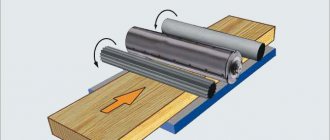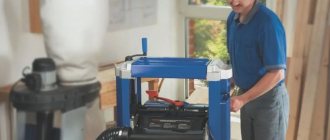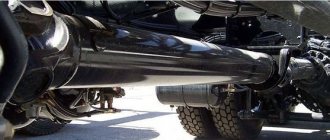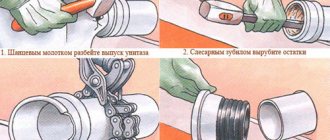Hand tools have never been canceled in a carpentry workshop, and one of the important tools is a marking thicknesser. The thing is reliable and practical. It is clear that now you can easily buy any instrument, but this is not always profitable when you are balancing between price and quality. It is quite possible to make a surface planer in your workshop.
Here are 8 options for different surface planers as a source of ideas for flights of fancy and gaining experience:
- Marking thicknesser from Yuri Raevsky
- Manufacturing of marking thicknesser from Mikhail Rebitator
- Curvilinear manual thicknesser from “Voxa 54”
- Carpenter's thicknessing compass for marking workpieces from "Drevo Woodwork"
- Homemade marking thicknesser from Sergei Petreev
- How to make a marking thicknesser in 5 minutes from Sergey Sergeich
- Thicknesser made of metal parts from Ilya Gonchar
- Homemade marking thicknesser based on a railing pipe from AlfFisher
Factory equipment for converting a plane into a machine
You can find special beds for sale on the domestic tool market. By attaching an electric planer to it, you can make a simple thickness planer. It is included in the delivery set with some models of planes.
A thickness planer allows you to plan wooden blanks much faster and more accurately. That is why it should be in the arsenal of every owner. We hope that after reading the article, everyone will be able to make such a machine on their own.
The best planer-thicknesser machines
There is no need to choose between the principles - you can combine them in one product, obtaining a budget-friendly and reliable tool.
CALIBER SSR-1600 1.6 kW
CALIBER SSR-1600 1.6 kW
The best model in the price-quality category. A simple and unpretentious surface thicknesser from a domestic manufacturer.
Characteristics:
- table length - 268 mm;
- table width - 208 mm;
- workpiece width - 204 mm;
- the maximum thicknessing depth parameter is 2 mm;
- workpiece feed - 6 m/min;
- maximum workpiece height - 120 mm;
- two cutting edges.
Pros:
- no initial setup required;
- cuts exactly to size.
There are no cons.
The product is one of those tools that require minimal modification with your own hands, after which it can serve for years.
BELMASH SDR-2200
BELMASH SDR-2200
This is a reliable model, which is designed for planing and thicknessing. All operations are performed quickly and give the workpiece the desired shape and size. Feeding is carried out manually, which is convenient and safe. The design is made in such a way that it makes it possible to easily move the product without special tools. The device has a wide table and a convenient start button.
Characteristics:
- equipped with a single-phase electric motor with a power of 2.2 kW;
- the shafts rotate at a speed of 7700 rpm;
- depth of planing and contouring - 3 mm, feed - 6 m/min;
- the table has dimensions of 425x260 mm, which will make it easier to work with large workpieces.
Pros:
- the plane shafts do not leave marks on the wood, and the sliding bushings have a long service life;
- the guide allows you to chamfer at an angle of 45 degrees along the entire length of the workpiece;
- The rip fence can be installed on both sides of the table.
Minuses:
- “extra functions” - difficult to figure out when using at home.
Owners complain about the need to adjust the legs after purchase.
Comparison of thicknesser and jointer machines
In addition to the surface planer, carpentry professionals actively use a jointer - a device with an elongated frame, designed for installation in a workshop. The main advantage is working with a long board. However, the thicknesser is not inferior in popularity. To understand why, you need to familiarize yourself with the advantages and disadvantages of each.
| View: | pros | Minuses |
| Jointer |
|
|
| Thicknesser |
|
|
How to make a thickness planer for wood at home
If necessary, such a machine can be made at home. This does not require the use of special equipment or special technical skills.
The simplest machine can be made by fixing the plane on the table in a sideways or upside-down position. More advanced models require more time and effort.
What is needed for making
To make a homemade thicknesser, you need a minimum set of materials and tools, which are often in the arsenal of every owner. It includes:
- electric plane;
- jigsaw;
- metal sheet 0.5 mm thick;
- laminated chipboard sheet;
- metal pipe;
- hand drill;
- set of drills for wood and metal;
- fastening hardware;
- set of wrenches.
Which plane to choose for this purpose?
The electric plane is the main working part of the machine. Therefore, before starting assembly, it is necessary to select a tool with optimal parameters. The main technical characteristics that should be taken into account when choosing a plane are:
- planing width. Most modern electric planers are equipped with a support sole and blades 82 mm wide. This is quite enough for household work;
- electric motor power. To carry out high-quality planing of workpieces, it is best to use planes with an electric motor power of 800 W or more. This will allow for high-quality planing;
- blade rotation speed . There is a direct relationship between the number of revolutions of the knife block and the quality of planing. In other words, the more revolutions the blades make, the cleaner the processed surface is.
The best choice for making a thickness planer would be the following tools:
- RESANTA P82/800;
- DIOLD RE-1100-01;
- INTERSKOL R82/710.
Rating of the best premium class machines
For professional carpenters.
BELMASH P380ARB 230 V
BELMASH P380ARB 230 V
A Belarusian-made product that uses a 230 V network for operation. Automatic feeding stands out among the features. The speed of the gear shaft can be adjusted between 5 and 9 meters per minute. The receiving shaft is of one-piece construction. Thanks to two table rollers, friction on the desktop area is reduced. Additional tables are also equipped with casters. Planing shaft with three knives that can be replaced with a helical shaft. It is possible to independently replace knives thanks to the presence of a special device.
Characteristics:
- power - 3050 W;
- asynchronous motor;
- shaft at idle speed - 5,000 rpm.
Pros:
- desktop clamp;
- helical shaft installation;
- the speed of automatic material feeding may vary;
- high precision.
There are no cons.
It works in many industries without causing any complaints.
Helical BELMASH P380ARBH (400 V)
Helical BELMASH P380ARBH (400 V)
In general, it has a similar design as the previous version. But to work you need a 380 V network.
Characteristics:
- power - 2200 W;
- special head - 75 knives on the shaft.
Pros:
- simplicity;
- reliability;
- functional.
Minuses:
- quite a complex cutting component.
Users are satisfied, there are no breakdowns.
JET JWP-208-3 5.5 kW
JET JWP-208-3 5.5 kW
In first place is a surface thicknesser from the Swiss brand Jet, which is intended for professional use in production. The machine is connected to a 380 V network, so the workshop must have a three-phase input. The model has its own base and bed with rollers, so it does not require a workbench.
Characteristics:
- table length - 654 mm;
- workpiece - 500 mm;
- jointing - 5 mm;
- broaching — 10 m/min;
- chain transmission;
- workpiece - 200 mm;
- four knives;
- stationary stand.
Pros:
- does not need a table or workbench;
- support rollers on the edges of the frame;
- the operator hardly feels the vibration;
- simple controls.
Minuses:
- voltage required 380 V;
- high price;
- consumes 5.5 kW per hour;
- Difficult to transport due to weight of 300 kg.
Powermatic 209
Powermatic 209
Belongs to the category of powerful and durable planes. The manufacturer claims a three-phase connection. Planing width is up to 500 mm. The shaft is equipped with conventional straight knives. It is equipped with a segmented spiral drum with carbide blades. The cast iron construction is durable and vibration is virtually eliminated. The height of the table is adjusted using a handwheel. The model is equipped with all the necessary settings and functions that ensure stable and comfortable operation for a long time. Ranked among the best.
Characteristics:
- 400 V;
- planing depth along the entire passage - 2 mm;
- workpiece length - 170 mm;
- thicknesser - 664 mm;
- thicknesser extensions - 1420 mm;
- exhaust fitting - 127 mm.
Pros:
- multifunctionality;
- reliability;
- high quality products;
- ability to work with wood of various densities;
- efficiency;
- user convenience.
- power;
- height adjustment;
- the wheeled chassis is equipped with a brake for easy movement around the workshop;
- well-thought-out basic and additional (auxiliary) functions by the manufacturer.
There are no cons.
T-600J
T-600J
Thicknesser PROMA T-600J is used for planing flat surfaces of wood workpieces with a rotating knife shaft. The model is equipped with a motor with a power supply voltage of 380 volts. The equipment of the production company PROMA is distinguished by the high quality of the work performed and a long service life. The quality cast iron work table is raised and lowered using a large handwheel.
Characteristics:
- width - 630 mm;
- thickness - 205 mm;
- length - 220 mm;
- planing depth - 5 mm;
- 4 knives.
Pros:
- powerful engine;
- stable design with no vibration;
- fast and accurate installation of knives;
- high-quality processing of workpieces thanks to a shaft with knives made of high-quality steel;
- convenient location of controls.
There are no cons.
A fairly unpretentious technique, while having good characteristics. No weak points found.
How to choose a good thickness planer for your home workshop
The characteristics of the thicknessing system for working with wood will affect the speed of the production cycle and the final cost of the product. To figure out which thicknesser to choose, you need to pay attention to the following parameters:
- Drum speed : Most often this will be limited to 10,000 rpm. This is the number we should strive for. However, the minimum acceptable speed will be 8,000 rpm. Along with the frequency, the speed of the process will increase.
- power . Manufacturers adhere to the general standard, installing motors from 1500 to 5500 W in products. The powerful power unit will plan wet or dense boards without any problems. It is important to pay attention to the required voltage in order to avoid installation errors.
- Indicator of permissible minimum thickness . For glazing beads and other thin strips, a thicknesser is required that stretches the workpiece with a cross-section of 5-7 millimeters. If such an attempt is made on conventional equipment that is not designed for such an operation, the picket fence will be broken.
- Number of knives per axis with sharpening features. There can be from one to four blades on the drum; the latter option increases the quality of the passage and reduces the time required for broaching. The blades can be smooth or wavy depending on the wooden plane.
- Maximum permitted dimensions of the part to be passed through . The dimensions of the portal frames of the surface planer have a direct impact on the permitted dimensions of the workpieces in height and width. This can be a board 140-200 mm high when working with an edge or sawn wood 280-500 mm.
- Possibility of working with a vacuum cleaner . Sawdust is thrown directly forward, which creates the need for constant cleaning in the workshop or workshop. By connecting a vacuum cleaner, you can eliminate the need for cleaning at the end of each working day.
- Parameter of depth of cut thickness . Each manufacturer indicates to what height a layer of the workpiece can be removed within one pass. The higher the indicator, the more productive the surface planer. The average value is 1-5 mm.
- Number of sides to process . If there is a drum with legs not only from below, but also from above, then the processing speed of uneven surfaces is multiplied by two.
- weight . Thicknesser can weigh from 20 to 50 kilograms. This equipment (in a manual version) can be installed on a workbench or a regular table or carried in a car when working locally. A lighter option would be preferable.











